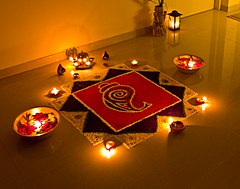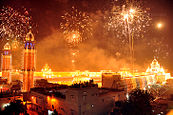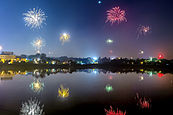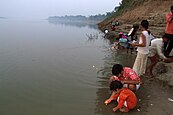Diwali
Deepavali" redirects here. For the Nepali festival, see Tihar. For the films, see Deepavali.

Rangoli decorations, made using coloured powder, are popular during Diwali
| |
| Also called | Deepavali, Festival of Lights |
| Observed by | Hindus, Sikhs, Jains and Buddhists [1] |
| Type | Hindu, cultural |
| Celebrations | Diya and lighting, home decoration, shopping, fireworks, puja (prayers), gifts, feast and sweets |
| Begins | Dhanteras, 2 days before Diwali |
| Ends | Bhai Dooj, 2 days after Diwali |
| Date | Varies per Hindu Lunisolar calendar |
| 2015 date | 10 November in South India,[2] 11 November[2] in North India |
| 2016 date | 30 October (Sunday) |
| 2017 date | 19 October (Thursday) |
| Related to | Kali Puja, Diwali (Jainism), Bandi Chhor Divas |
| Part of a series on |
| Hinduism |
|---|
 |
Before Diwali night, people clean, renovate and decorate their homes and offices.[8] On Diwali night, Hindus dress up in new clothes or their best outfit, light up diyas (lamps and candles) inside and outside their home, participate in family puja (prayers) typically to Lakshmi – the goddess of wealth and prosperity. After puja, fireworks follow,[9] then a family feast including mithai (sweets), and an exchange of gifts between family members and close friends. Diwali also marks a major shopping period in nations where it is celebrated.[10]
Diwali is an important festival for Hindus. The name of festive days as well as the rituals of Diwali vary significantly among Hindus, based on the region of India. In many parts of India,[11] the festivities start with Dhanteras, followed by Naraka Chaturdasi on second day, Diwali on the third day, Diwali Padva dedicated to wife–husband relationship on the fourth day, and festivities end with Bhau-beej dedicated to sister–brother bond on the fifth day. Dhanteras usually falls eighteen days after Dussehra.
On the same night that Hindus celebrate Diwali, Jains celebrate a festival of lights to mark the attainment of moksha by Mahavira,[12][13] and Sikhs celebrate Bandi Chhor Divas. Diwali is an official holiday in Nepal, India,[14] Sri Lanka, Myanmar, Mauritius, Guyana, Trinidad and Tobago, Suriname, Malaysia, Singapore, Fiji and Pakistan.
Contents
[hide]Etymology[edit]
| |||||||||
Diwali (English pronunciation: /dɨˈwɑːliː/)[3] is variously named and spelled/pronounced in diverse languages of India: 'deepabali' (Odia: ଦିପାବଲି), 'deepaboli' (Bengali: দীপাবলী), 'deepavali' (Assamese: দীপাৱলী, Kannada: ದೀಪಾವಳಿ, Malayalam: ദീപാവലി, Tamil: தீபாவளி and Telugu: దీపావళి), 'divali' (Gujarati: દિવાળી, Hindi: दिवाली,Marathi: दिवाळी,Konkani: दिवाळी, Punjabi: ਦੀਵਾਲੀ), 'diyari' (Sindhi: दियारी), and 'tihar' (Nepali: तिहार).
History[edit]
Diwali dates back to ancient times in India, as a festival after the summer harvest in the Hindu calendar month of Kartika. The festival is mentioned in Sanskrit scriptures such as the Padma Purana, the Skanda Purana both completed in second half of 1st millennium AD but believed to have been expanded from a core text from an earlier era. The diyas (lamps) are mentioned in Skanda Purana to symbolically represent parts of sun, the cosmic giver of light and energy to all life, who seasonally transitions in the Hindu calendar month of Kartik.[16][22] Hindus in some regions of India associate Diwali with the legend of Yama and Nachiketa on Kartika amavasya (Diwali night).[23] The Nachiketa story about right versus wrong, transient wealth versus true wealth, ignorance versus knowledge is recorded in Katha Upanishad composed in 1st millennium BC.[24]King Harsha in the 7th century Sanskrit play Nagananda mentions Diwali as Deepapratipadutsava, where lamps were lit and newly engaged brides and grooms were given gifts.[25][26] Rajasekhara referred to Diwali as Dipamalika in his 9th century Kavyamimamsa, wherein he mentions the tradition of homes being whitewashed and oil lamps decorating homes, streets and markets in the night.[25] The Persian traveller and historian Al Biruni, in his 11th century memoir on India, wrote Diwali being celebrated by Hindus on New Moon day of the month of Kartika.[27]
Significance[edit]
Diwali is one of the happiest holidays in Nepal and India with significant preparations. People clean their homes and decorate them for the festivities. Diwali is one of the biggest shopping seasons in Nepal and India; people buy new clothes for themselves and their families, as well as gifts, appliances, kitchen utensils, even expensive items such as cars and gold jewelry.[28] People also buy gifts for family members and friends which typically include sweets, dry fruits, and seasonal specialties depending on regional harvest and customs. It is also the period when children hear ancient stories, legends, myths about battles between good and evil or light and darkness from their parents and elders. Girls and women go shopping and create rangoli and other creative patterns on floors, near doors and walkways. Youth and adults alike help with lighting and preparing for patakhe (fireworks).[17][29]There is significant variation in regional practices and rituals. Depending on the region, prayers are offered before one or more deities, with most common being Lakshmi – the goddess of wealth and prosperity. On Diwali night, fireworks light up the neighborhood skies. Later, family members and invited friends celebrate the night over food and sweets.[17][29]









No comments:
Post a Comment